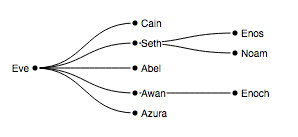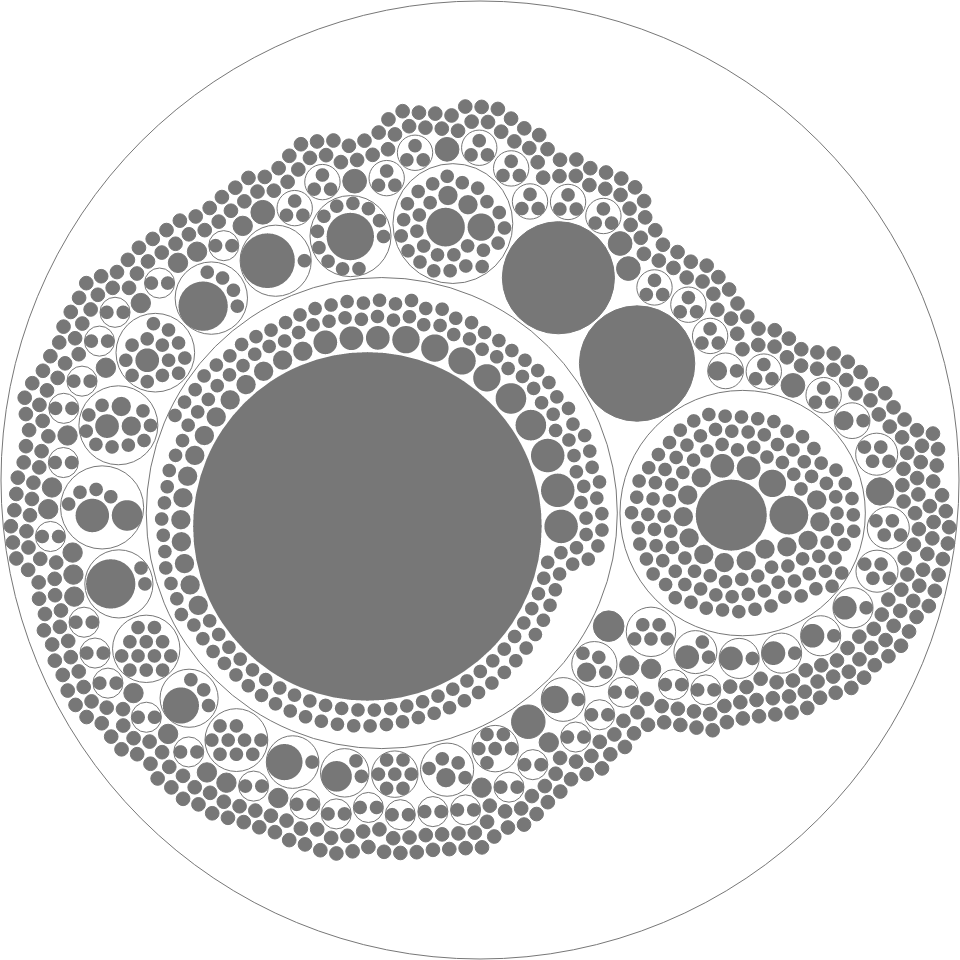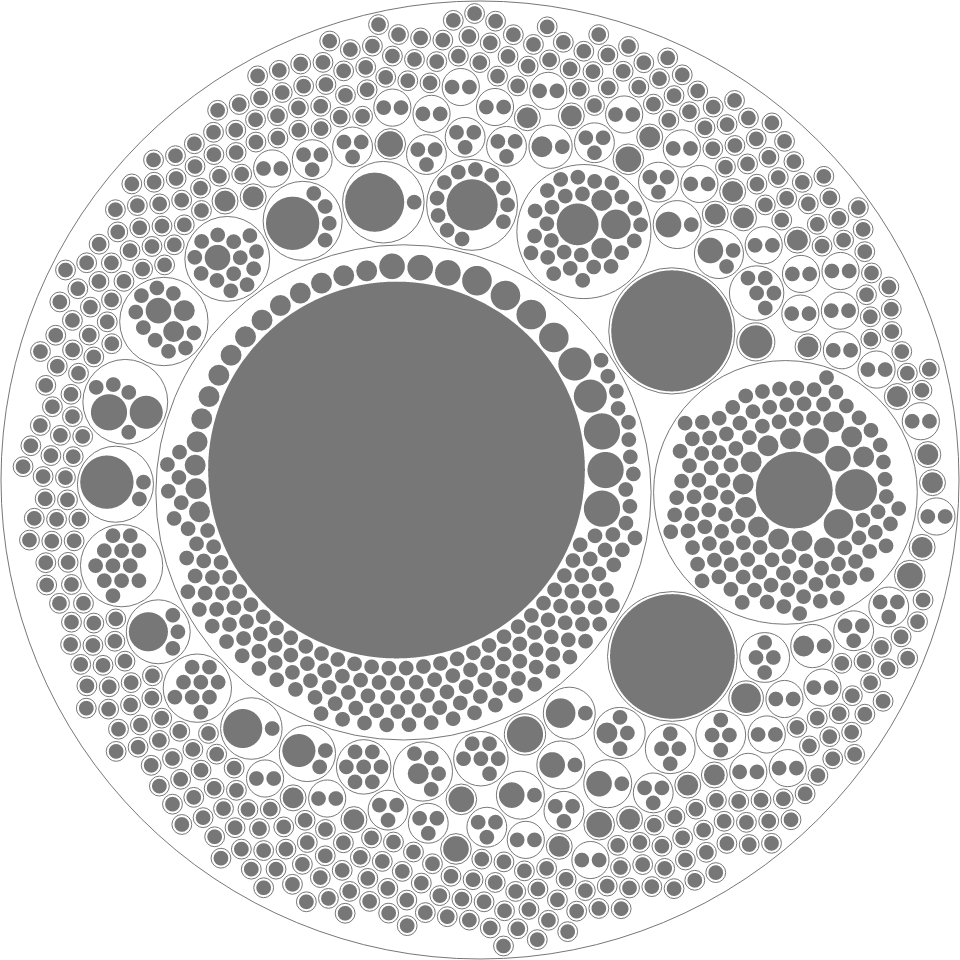Releases: d3/d3-hierarchy
v1.1.5
- Re-implement d3.packEnclose using Matoušek-Sharir-Welzl. Thanks, @robinhouston! (#84)
- Fix d3.packSiblings to center the circles more consistently around a fixed origin. (#81)
v1.1.4
v1.1.3
v1.1.2
v1.1.1
v1.1.0
- Add node.count.
- Fix overlapping circles in d3.pack and d3.packSiblings. (#74)
v1.0.3
v1.0.2
v1.0.1
v1.0.0
- First stable release.
Changes since D3 3.x
Pursuant to the great namespace flattening:
- d3.layout.cluster ↦ d3.cluster
- d3.layout.hierarchy ↦ d3.hierarchy
- d3.layout.pack ↦ d3.pack
- d3.layout.partition ↦ d3.partition
- d3.layout.tree ↦ d3.tree
- d3.layout.treemap ↦ d3.treemap
As an alternative to using JSON to represent hierarchical data (such as the “flare.json format” used by many D3 examples), the new d3.stratify operator simplifies the conversion of tabular data to hierarchical data! This is convenient if you already have data in a tabular format, such as the result of a SQL query or a CSV file:
name,parent
Eve,
Cain,Eve
Seth,Eve
Enos,Seth
Noam,Seth
Abel,Eve
Awan,Eve
Enoch,Awan
Azura,Eve
To convert this to a root node:
var root = d3.stratify()
.id(function(d) { return d.name; })
.parentId(function(d) { return d.parent; })
(nodes);The resulting root can be passed to d3.tree to produce a tree diagram like this:
Root nodes can also be created from JSON data using d3.hierarchy. The hierarchy layouts now take these root nodes as input rather than operating directly on JSON data, which helps to provide a cleaner separation between the input data and the computed layout. (For example, use node.copy to isolate layout changes.) It also simplifies the API: rather than each hierarchy layout needing to implement value and sorting accessors, there are now generic node.sum and node.sort methods that work with any hierarchy layout.
The new d3.hierarchy API also provides a richer set of methods for manipulating hierarchical data. For example, to generate an array of all nodes in topological order, use node.descendants; for just leaf nodes, use node.leaves. To highlight the ancestors of a given node on mouseover, use node.ancestors. To generate an array of {source, target} links for a given hierarchy, use node.links; this replaces treemap.links and similar methods on the other layouts. The new node.path method replaces d3.layout.bundle; see also d3.curveBundle for hierarchical edge bundling. There are also .
The hierarchy layouts have been rewritten using new, non-recursive traversal methods (node.each, node.eachAfter and node.eachBefore), improving performance on large datasets. The d3.tree layout no longer uses a node._ field to store temporary state during layout.
Treemap tiling is now extensible via treemap.tile! The default squarified tiling algorithm, d3.treemapSquarify, has been completely rewritten, improving performance and fixing bugs in padding and rounding. The treemap.sticky method has been replaced with the d3.treemapResquarify, which is identical to d3.treemapSquarify except it performs stable neighbor-preserving updates. The treemap.ratio method has been replaced with squarify.ratio. And there’s a new d3.treemapBinary for binary treemaps!
Treemap padding has also been improved. The treemap now distinguishes between outer padding that separates a parent from its children, and inner padding that separates adjacent siblings. You can set the top-, right-, bottom- and left-outer padding separately. There are new examples for the traditional nested treemap and for Lü and Fogarty’s cascaded treemap. And there’s a new example demonstrating d3.nest with d3.treemap.
The space-filling layouts d3.treemap and d3.partition now output x0, x1, y0, y1 on each node instead of x0, dx, y0, dy. This improves accuracy by ensuring that the edges of adjacent cells are exactly equal, rather than sometimes being slightly off due to floating point math. The partition layout now supports rounding and padding.
The circle-packing layout, d3.pack, has been completely rewritten to better implement Wang et al.’s algorithm, fixing major bugs and improving results! Welzl’s algorithm is now used to compute the exact smallest enclosing circle for each parent, rather than the approximate answer used by Wang et al. The 3.x output is shown on the left; 4.0 is shown on the right:
A non-hierarchical implementation is also available as d3.packSiblings, and the smallest enclosing circle implementation is available as d3.packEnclose. Pack padding now applies between a parent and its children, as well as between adjacent siblings. In addition, you can now specify padding as a function that is computed dynamically for each parent.
See CHANGES for all D3 changes since 3.x.


